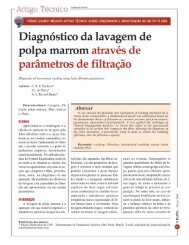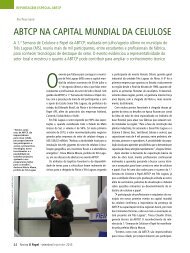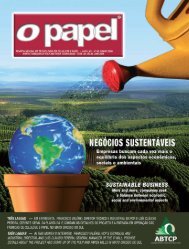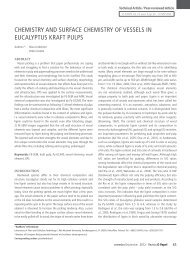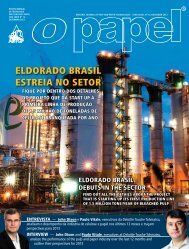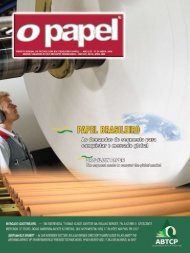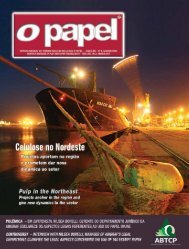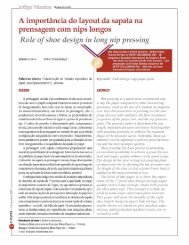international article - Revista O Papel
international article - Revista O Papel
international article - Revista O Papel
Create successful ePaper yourself
Turn your PDF publications into a flip-book with our unique Google optimized e-Paper software.
Decomposição da energia de refinação<br />
A aplicação do balanço energético geral anteriormente<br />
apresentado (Equação 2) e modificado para o processo de<br />
refinação estudado, resulta em:<br />
Equação 4<br />
Refining energy break down<br />
Application of the general energy balance earlier<br />
presented (Equation 2) and modified for the studied<br />
refining process turn into:<br />
Equation 4<br />
O PAPEL vol. 70, num. 10, pp. 41 - 60 OCT 2009<br />
já que se supôs que os componentes E entrada de massa<br />
, E saída de massa<br />
,<br />
Q de entrada<br />
e W de saída<br />
fossem todos iguais a zero. O estabelecimento<br />
teórico de um balanço pode parecer simples e fácil,<br />
enquanto a sua aplicação pode estar associada a problemas<br />
na determinação confiável dos componentes. Isto se deve, sobretudo,<br />
a interações entre as fibras e a natureza viscoelástica<br />
das fibras celulósicas. A energia despendida em modificação<br />
das fibras, de acordo com a Figura 1, pode ser subdividida em<br />
caráter adicional da maneira mostrada na Figura 7.<br />
Portanto, uma parcela preponderante, ou até mesmo a<br />
totalidade, da energia elétrica de processo introduzida seria<br />
convertida em calor sensível em alguma fase do processo.<br />
Alguns autores têm afirmado que o aumento da temperatura da<br />
massa é um sintoma de energia desperdiçada (North e Samuels<br />
1948). Diversos autores têm estimado a dissipação da energia<br />
de refinação efetiva: Kraske e Koon (1956) calcularam que<br />
98%–100% da mesma aparecia como calor sensível; Motshman<br />
(1931), Milne (1936) e Westman (1984) propuseram dissipação<br />
total da energia de refinação. Nordman et al. (1981) estimaram<br />
que 90%-95% da energia elétrica de entrada transformava-se<br />
em calor. Nissan (1977) explicou isto ao propor um mecanismo<br />
em que a energia despendida entre as barras do refinador<br />
em deformar elasticamente as fibras é relaxada por vibrações<br />
amortecidas e convertida em calor quando as fibras são liberadas.<br />
Atalla e Wahren (1980) sustentaram o mesmo parecer<br />
Energia de modificação das fibras<br />
Fibre modification energy<br />
Forças (x distância) sobre as fibras<br />
Forces (x distance) on fibres<br />
since the components E mass,in<br />
, E mass,out<br />
, Q in<br />
and W out<br />
all<br />
were assumed to be zero. Theoretical set-up of a balance<br />
may seem straightforward, whereas its application<br />
may be associated with problems in reliable<br />
determination of the components. This is mainly due<br />
to fibre interactions and the viscoelastic nature of<br />
pulp fibres. The energy spent on fibre modification,<br />
according to Figure 1, may further be sub-divided<br />
as shown in Figure 7.<br />
Thus, a majority, or even all, of the introduced<br />
electric process energy would be converted into sensible<br />
heat at some stage. Some authors have felt that<br />
the rise in stock temperature is a symptom of wasted<br />
energy (North and Samuels 1948). Several authors<br />
have estimated the dissipation of the effective refining<br />
energy: Kraske and Koon (1956) calculated<br />
that 98%–100% of this appeared as sensible heat;<br />
Motshman (1931), Milne (1936) and Westman (1984)<br />
proposed total refiner energy dissipation. Nordman<br />
et al. (1981) estimated that 90%-95% of the input<br />
electrical energy turned into heat. Nissan (1977)<br />
has explained this by proposing a mechanism where<br />
the energy spent between refiner bars on elastically<br />
straining the fibres is relaxed by damped vibrations<br />
and turned into heat when the fibres are released.<br />
O PAPEL - Outubro 2009<br />
50<br />
Deformação elástica (reversível)<br />
Elastic (reversible) deformation<br />
Calor / Heat<br />
Viscoelástica (parcialmente reversível)<br />
Viscoelastic (partly reversible)<br />
Modificação das fibras (+ calor)<br />
Fibre modification (+ heat)<br />
Deformação plástica (irreversível)<br />
Plastic (irreversible) deformation<br />
Figura 7. Decomposição da energia de modificação das fibras em deformações reversíveis e irreversíveis da parede celular das fibras.<br />
A energia mecânica introduzida é principalmente dissipada em forma de calor / Figure 7. Break down of fibre modification energy into<br />
reversible and irreversible fibre cell wall deformations. The introduced mechanical energy is mainly dissipated into heat



